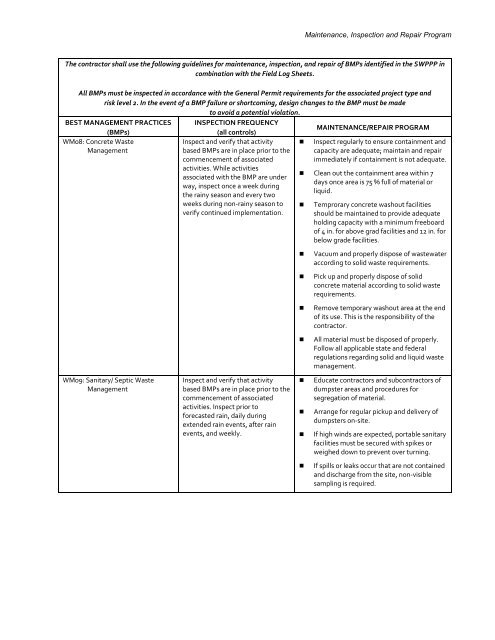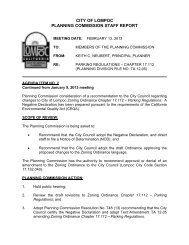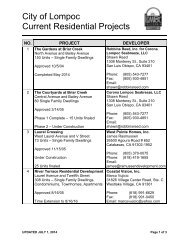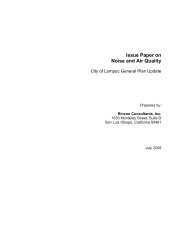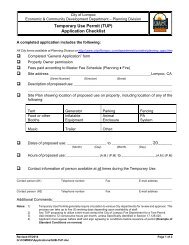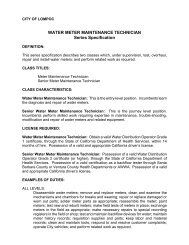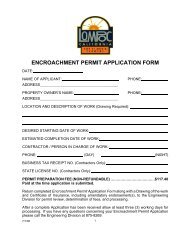Storm Water Pollution Prevention Plan (SWPPP) - the City of Lompoc!
Storm Water Pollution Prevention Plan (SWPPP) - the City of Lompoc!
Storm Water Pollution Prevention Plan (SWPPP) - the City of Lompoc!
You also want an ePaper? Increase the reach of your titles
YUMPU automatically turns print PDFs into web optimized ePapers that Google loves.
Maintenance, Inspection and Repair ProgramThe contractor shall use <strong>the</strong> following guidelines for maintenance, inspection, and repair <strong>of</strong> BMPs identified in <strong>the</strong> <strong>SWPPP</strong> incombination with <strong>the</strong> Field Log Sheets.All BMPs must be inspected in accordance with <strong>the</strong> General Permit requirements for <strong>the</strong> associated project type andrisk level 2. In <strong>the</strong> event <strong>of</strong> a BMP failure or shortcoming, design changes to <strong>the</strong> BMP must be madeto avoid a potential violation.BEST MANAGEMENT PRACTICES INSPECTION FREQUENCYMAINTENANCE/REPAIR PROGRAM(BMPs)(all controls)WM08: Concrete WasteManagementWM09: Sanitary/ Septic WasteManagementInspect and verify that activitybased BMPs are in place prior to <strong>the</strong>commencement <strong>of</strong> associatedactivities. While activitiesassociated with <strong>the</strong> BMP are underway, inspect once a week during<strong>the</strong> rainy season and every twoweeks during non‐rainy season toverify continued implementation.Inspect and verify that activitybased BMPs are in place prior to <strong>the</strong>commencement <strong>of</strong> associatedactivities. Inspect prior t<strong>of</strong>orecasted rain, daily duringextended rain events, after rainevents, and weekly.• Inspect regularly to ensure containment andcapacity are adequate; maintain and repairimmediately if containment is not adequate.• Clean out <strong>the</strong> containment area within 7days once area is 75 % full <strong>of</strong> material orliquid.• Temprorary concrete washout facilitiesshould be maintained to provide adequateholding capacity with a minimum freeboard<strong>of</strong> 4 in. for above grad facilities and 12 in. forbelow grade facilities.• Vacuum and properly dispose <strong>of</strong> wastewateraccording to solid waste requirements.• Pick up and properly dispose <strong>of</strong> solidconcrete material according to solid wasterequirements.• Remove temporary washout area at <strong>the</strong> end<strong>of</strong> its use. This is <strong>the</strong> responsibility <strong>of</strong> <strong>the</strong>contractor.• All material must be disposed <strong>of</strong> properly.Follow all applicable state and federalregulations regarding solid and liquid wastemanagement.• Educate contractors and subcontractors <strong>of</strong>dumpster areas and procedures forsegregation <strong>of</strong> material.• Arrange for regular pickup and delivery <strong>of</strong>dumpsters on‐site.• If high winds are expected, portable sanitaryfacilities must be secured with spikes orweighed down to prevent over turning.• If spills or leaks occur that are not containedand discharge from <strong>the</strong> site, non‐visiblesampling is required.


